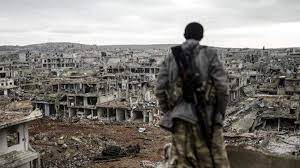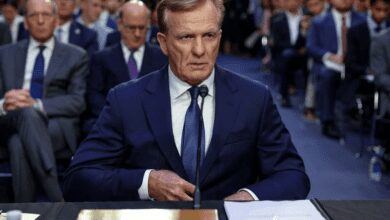Why are Americans unable to see or hear what is happening in the courtroom during the Trump trial?
The first US president to be charged with a crime in an American courtroom is a historic occasion. However, very few witnesses are able to see or even hear what is happening.

Rather, the majority of the country is learning about the former president Donald Trump’s hush money trial via rumors. Reporters in a Manhattan courtroom are required to report afterwards to the outside world on what is being said, beginning with preliminary arguments and jury selection on Monday.
That’s all because one of the strictest state laws in the nation governs media coverage of court hearings is found in New York. The murder trial of O.J. Simpson, whose death occurred last week and was broadcast live from a California courtroom to a whole country thirty years ago, served as a stark reminder of how New York is either behind the times or a holdout.
CAN YOU PLEASE LET ME SEE IT, NEW YORK?
According to a 2022 report by the New York-based Fund for Modern Courts, the spectacle of bright flashbulbs and camera operators standing on witness tables during the 1935 trial of the man accused of kidnapping and killing Charles Lindbergh’s baby son horrified the legal community, which is why there are regulations restricting media coverage in courtrooms today.
According to the study, defense attorneys were concerned that video coverage would hurt their cases, so rules to preserve decorum spread throughout the country and were modified to take television into consideration.
However, a desire for transparent governance eroded these rules, and video cameras were eventually allowed in courts all around the nation, often at the whim of the individual judges handling each case.
Between 1987 until 1997, they were also permitted in New York on an experimental basis before being shut down. According to Victor Kovner, a former corporation counsel for New York City who supports open courts, defense lawyer lobbyists are still powerful in New York and have special influence on attorneys in the state Assembly.
According to the Fund for Modern Courts, the only states that still have significant restrictions on video coverage are New York and Louisiana.
That seems absurd to Kovner and other people.
“We like to think of ourselves as the media capital of the world, so it’s unacceptable that cameras aren’t allowed in one of our three branches of government,” said Sen. Brad Hoylman-Sigal of New York State, who is the author of a measure that aims to alter that.
The senator described it as “one of the most consequential trials of our modern age.” “I believe it is the public’s right to know exactly what takes place in that courtroom.”
Wait, at the beginning of the trial, I saw a picture of Trump in court.
This is due to the fact that before the day’s hearings began, presiding judge Juan M. Merchan allowed a few still photographers to take pictures of Trump. Once the court is in session, courtroom sketch artists, a fading medium of communication, are in charge.
In fact, there is some video coverage of the trial that may be seen on monitors in the area next to the main courthouse that serves as an overflow. On Monday, the courtroom was crowded with reporters, law enforcement agents, and some members of the public. Among them was Ron Sinibaldi, a retired Long Island accountant who had waited outside the building until after midnight to get a seat.
Sinibaldi said, “I read biographies of presidents.” “I visit libraries run by presidents. I came to see the history.
WAYS TO GET AROUND THE RESTRICTIONS FOR THOSE INVOLVED?
A small group of reporters and a few cameras are set up in a corridor outside the courthouse to record any statements made by trial participants who would want to address the public. That includes Trump, even prior to the initiation of the proceedings.
In the event that the trial is not covered live, the public’s perception of the case will be greatly influenced by the former president’s frequent use of the cameras and whether or not his comments are broadcast live, on video, or not at all by news outlets.
His statements were broadcast live on MSNBC on Monday morning. Regarding the Trump defense team, CNN correspondent Phil Mattingly said, “They’re trying to grab the narrative regardless of the outcome.”
HOW ARE JOURNALISTS MANAGING THE TRIAL IN THEIR COVERAGE?
a little challengingly. Outside the courthouse, CNN set up shop on Manhattan’s streets with a crew. A vehicle adorned with pro-Trump flags would often pass by, blasting music and honking horns. It was not always easy for reporters to be heard. “This place is a bit of a circus,” CNN’s Kaitlan Collins said.
Experts and pundits, many of whom had been on juries before, provided commentary from out of court or from studios. “Most cities, at least those outside of New York,” according to Fox News commentator Jonathan Turley, would see the case as a weaponization of the criminal justice system.
Journalists will have plenty of time on their hands unless they divert their focus, since estimates suggest that jury selection might take up to two weeks, and there is no way to demonstrate it.
WILL THERE BE MORE TRUMP CASES AIRED ON TV?
Judges in Georgia, where Trump is accused of interfering in the election, have the authority to decide whether to allow media cameras. Judge Scott McAfee of the Fulton County Superior Court has declared that all hearings and trials in that case would be televised. Hearings on whether to let Fulton County District Attorney Fani Willis to present the case have already taken place.
In criminal trials, federal courts do not permit the use of cameras. It is unclear when or when trials for Trump’s misuse of sensitive materials and election meddling will occur. The president is the subject of two distinct criminal proceedings.
One ray of light from the federal government comes from the US Supreme Court, which allows audio recordings of oral arguments to be played outside of court. However, there’s no evidence that Trump’s situation would fall under this. The hush money trial cannot be covered on audio according to New York law.
Legislators who want to allow electronic media to cover New York courts are optimistic that the publicity surrounding the Trump case would help their cause. Currently, the notion is being discussed in discussions over the state budget for New York, so if the bill is enacted and promptly implemented, it would potentially have an impact on the Trump trial.
It’s better not to bank on it given the history of New York state.







